
Khalkhin-Gol, subtitled "Tactical Game of the Soviet Japanese War", is a board game published by Simulations Design Corporation (SDC) in 1973 that simulates the decisive battle between Soviet and Japanese forces in 1939.

Khalkhin-Gol, subtitled "Tactical Game of the Soviet Japanese War", is a board game published by Simulations Design Corporation (SDC) in 1973 that simulates the decisive battle between Soviet and Japanese forces in 1939.
In 1938, Japanese forces that had occupied Manchuria tried to expand into Mongolia, which was allied with the Soviet Union, leading to the Soviet–Japanese War. There were a number of skirmishes near the Khalkin Gol River before the Soviets attacked in force near the village of Nomonhan on 20 August 1939. [1]
Khalkhin-Gol is a two-player regimental level game in which the battle from the Soviet-Japanese war is depicted, on the sandy plains and marshes of Mongolia, featuring infantry armies with some tanks, cavalry and artillery. [2] With a 17" x 36" mape and only 100 counters, the game is relatively simple, using a standard "I Go, You Go" system of alternating turns. [3]
There is only one scenario that is twelve turns long. [4]
In 1973, Dana Lombardy and M.A. Ramsay designed Khalkin-Gol, and it was published as a pull-out game in Issue #5 (June 1973) of SDC's house magazine Conflict. SDC also published it as their fifth "pouch game" (packaged in a ziplock bag).
In a 1976 poll conducted by SPI to determine the most popular wargames in North America, Khalkin-Gol was rated a very poor 159th out of 202 games. [2]
In the 1977 book The Comprehensive Guide to Board Wargaming , Nicholas Palmer described the game as a "Simple system with considerable realism" and described the depicted scenario as "A tough battle - including infantry leaping onto tanks to destroy them!" [2]
In Issue 15 of the UK wargaming magazine Phoenix , Ron Levell called the counters "disappointing", saying "to call the counters square would be flattering. No two are exactly alike." He thought the Combat Result Table was particularly "bloody" and predicted that "only a dozen units [will be] on the map by the end of the game." Levell also found the victory conditions favored the Japanese player, commenting that "A certain amount of fiddling is required to balance the game." He thought that it was "A challenging game with unusual rules and excellent for the beginner to desert warfare, although experienced players may feel the whole situation is artificial." However, he concluded on a negative note, saying, "unless you are a fanatic on minor engagements in Mongolia (like myself), it is not worth buying [...] unless you are prepared to go to great lengths modifying the rules." [3]
In a retrospective review in Issue 5 of Simulacrum, Brian Train commented "Both sides race around each other's flanks in an effort to destroy enemy units and get to the other side of the Halha River. The speedy units, open flanks and simple victory conditions make for a game that plays in well under two hours." [4]

The Battles of Khalkhin Gol were the decisive engagements of the undeclared Soviet–Japanese border conflicts involving the Soviet Union, Mongolia, Japan and Manchukuo in 1939. The conflict was named after the river Khalkhin Gol, which passes through the battlefield. In Japan, the decisive battle of the conflict is known as the Nomonhan Incident after Nomonhan, a nearby village on the border between Mongolia and Manchuria. The battles resulted in the defeat of the Japanese Sixth Army.

PanzerBlitz is a tactical-scale board wargame published by Avalon Hill in 1970 that simulates armored combat set on the Eastern Front of World War II. The game, which was the most popular board wargame of the 1970s, is notable for being the first true board-based tactical-level, commercially available conflict simulation wargame. It also pioneered several concepts that would become industry standards.

The Mongolian People's Army, also known as the Mongolian People's Revolutionary Army or the Mongolian Red Army, was an institution of the Mongolian People's Revolutionary Party constituting as the armed forces of the Mongolian People's Republic. It was established on 18 March 1921 as a secondary army under Soviet Red Army command during the 1920s and during World War II. In 1992, the army's structure changed and then reorganized and renamed as the Mongolian Armed Forces.

Invasion: America, subtitled "Death Throes of the Superpower", is a near-future board wargame published by SPI in 1976 that simulates a hypothetical coordinated attack on North America by various factions.

Alexander the Great is a board wargame first published by Guidon Games in 1971 that simulates the Battle of Arbela in 331 BCE, also known as the Battle of Gaugamela. A revised edition was published by Avalon Hill in 1974. Both editions of the game were notable for having what one critic described as "one of the ugliest maps ever to curse a war game."
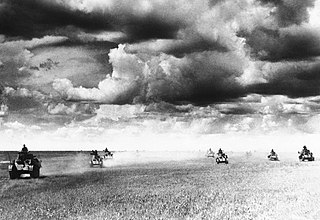
The Soviet–Japanese border conflicts, also known as the Soviet-Japanese Border War, the First Soviet-Japanese War, the Russo-Mongolian-Japanese Border Wars or the Soviet-Mongolian-Japanese Border Wars, were a series of minor and major conflicts fought between the Soviet Union, Mongolia and Japan in Northeast Asia from 1932 to 1939.
Yasuoka Detachment or Yasuoka Task Force, was an armored Japanese Imperial Army unit in 1939. It was commanded by Lt. General Yasuoka Masaomi, composed of 3rd Tank Regiment and 4th Tank Regiment, 64th Infantry Regiment/IJA 23rd Division, 2/28th Infantry Regiment/IJA 7th Division, the 2nd Battalion of the 13th Field Artillery Regiment, and 24th Independent Engineer Regiment. It was an armored Detachment of the Kwantung Army organized for the Japanese July 1939 offensive of the Battle of Khalkhin Gol.

Napoleon's Last Battles is a board wargame published by Simulations Publications in 1976 that simulates the last four battles fought by Napoleon. It was one of SPI's most popular games, and also received many positive reviews.
Stuart D. Goldman is an American historian and author. His most recent book is Nomonhan, 1939: The Red Army's Victory that Shaped World War II, about the little-known but highly consequential battle of Nomonhan/Khalkin Gol/, published by the US Naval Institute Press. He has also published numerous articles in World War II magazine.

The Marne: Home Before the Leaves Fall is a board wargame published by Simulations Publications Inc. (SPI) in 1972 that is a strategic simulation of the First Battle of the Marne during World War I. The subtitle is attributed to Wilhelm II, who supposedly told German soldiers in August 1914 "You will be home before the leaves fall from the trees."
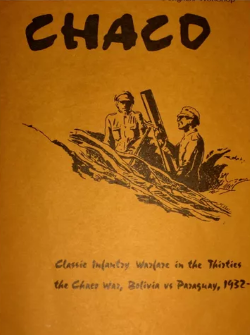
Chaco, subtitled "Classical Infantry Warfare in the Thirties", is a board wargame published by Game Designers' Workshop (GDW) in 1973 that simulates the 20th-century Chaco War between Bolivia and Paraguay.
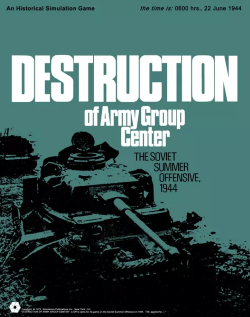
Destruction of Army Group Center, subtitled "The Soviet Summer Offensive, 1944" and often shortened to DAGC, is a board wargame published by Simulations Publications Inc. (SPI) in 1973 that simulates Operation Bagration, the June 1944 Soviet offensive during World War II that shattered the German line and marked the start of Germany's long retreat back to Berlin and the end of the war.

Island War: Four Pacific Battles is a collection of four board wargames published in 1975 by Simulations Publications Inc. (SPI) that simulates various battles between American and Japanese forces during the Pacific Campaign of World War II.

Jerusalem! Tactical Game of the 1948 War is a board wargame published by Simulations Design Corporation (SDC) in 1975 that simulates the 1948 Arab–Israeli War.

KampfPanzer: Armored Combat, 1937–40 is a board wargame published by Simulations Publications Inc. (SPI) in 1973 that simulates the first battles involving battle tanks.
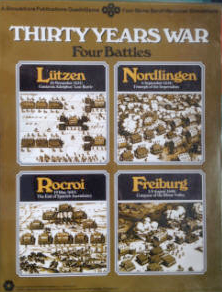
Thirty Years War, subtitled "Four Battles", is a "quadrigame" — four separate board wargames packaged in one box that use a common set of rules — published by Simulations Publications Inc. (SPI) in 1976. The four games simulate different battles during the Thirty Years' War, and were sold individually as well as in the quadrigame format. Some of the games were well received by critics, but overall, the quadrigame did not sell well.

Westwall: Four Battles to Germany is a collection of four board wargames published by Simulations Publications (SPI) in 1976 that simulate battles in Europe in late 1944 and early 1945 during World War II.
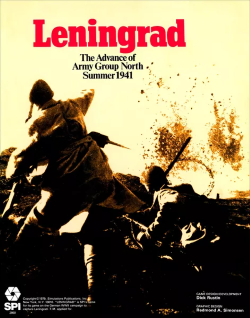
Leningrad: The Advance of Army Group North, Summer 1941 is a board wargame published by Simulations Publications Inc. (SPI) in 1980 that simulates the German drive on Leningrad during Operation Barbarossa in World War II, and the Soviet attempt to prevent a quick German victory. Although the game received good critical reception as a relatively simple game that could be an entry point for new wargamers, it was not a bestseller for SPI.

Mukden: Sino-Soviet Combat in the '70s is a board wargame published by Simulations Publications Inc. (SPI) in 1975 that simulates a contemporary hypothetical battle between Soviet and Chinese forces near the city of Mukden. It was one of four games that were part of the "quadrigame" titled Modern Battles: Four Contemporary Conflicts, but it was also released as an individual game. In a 1976 poll, Mukden was the least popular of the four games in Modern Battles.

Dien Bien Phu, subtitled "Strategic Game of Indochina 1950-55" is a board wargame published by Simulations Design Corporation (SDC) in 1973 that simulates the final five years of the First Indochina War in the northern French protectorate of Tonkin.